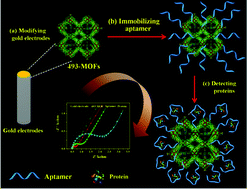Pore modulation of zirconium–organic frameworks for high-efficiency detection of trace proteins†
Abstract
Tunable electrochemical biosensors based on analogous Zr-MOFs were developed for protein detection, the performances of which rely on the pore sizes and surroundings of the MOFs that show diverse binding behaviors to aptamers and then the targeted proteins. The optimized Zr-MOF-based sensor has high selectivity to lysozyme in a wide concentration range and a low detection limit of 3.6 pg mL−1, with good repeatability, stability, and applicability in real samples. This work will establish a new platform for biosensing and extend the application scope of MOF materials.



 Please wait while we load your content...
Please wait while we load your content...